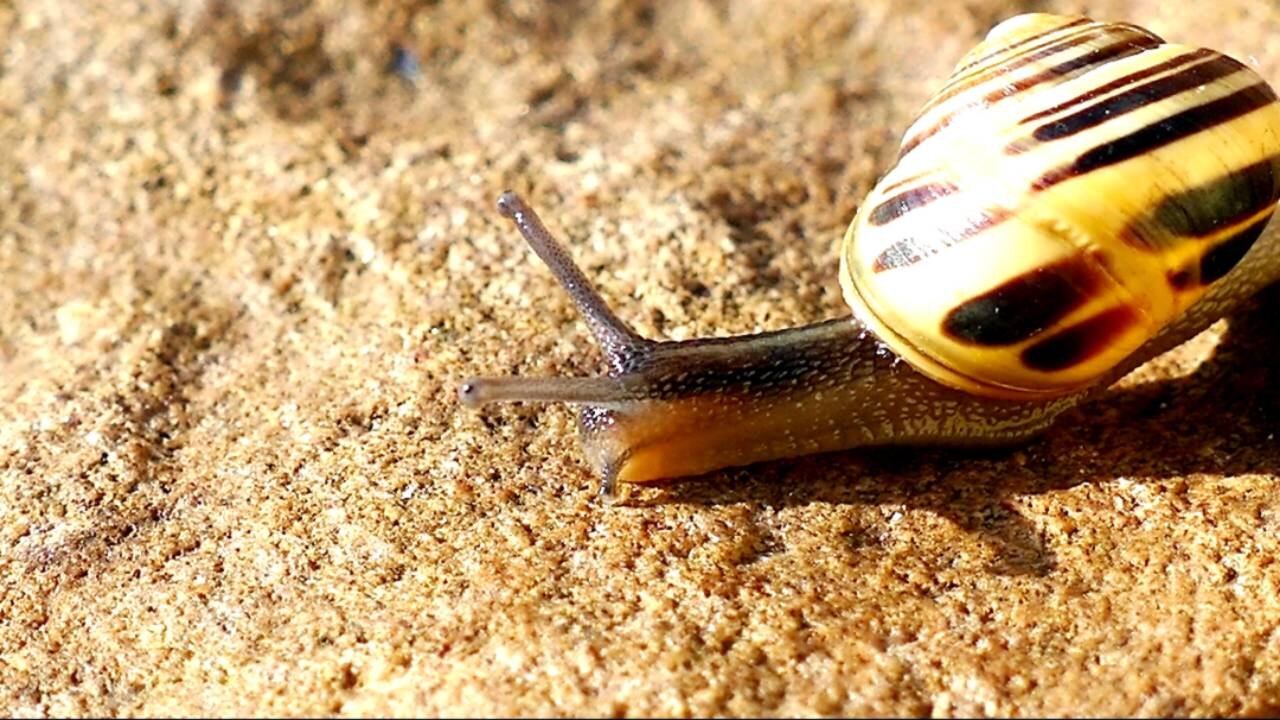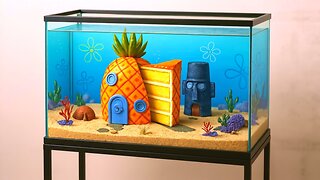Premium Only Content

The Beautiful Garden Snail Is It a Pet or Pest?
Would You Call A Garden Snail A Pet or Pest?
The garden snail has a pale grey, moist skin and a large, brown or yellowish shell with paler flecking and darker, spiraling bands. They are widespread and common throughout the UK and often considered garden pests. They come out at night to feed and rest during the day in sheltered places, such as under rocks.
land snail, any of the approximately 35,000 species of snails (phylum Mollusca) adapted to life away from water. Most species are members of the subclass Pulmonata (class Gastropoda); a few are members of the subclass Prosobranchia. Typically, land snails live on or near the ground, feed on decaying plant matter, and lay their eggs in the soil. They are most common on tropical islands but occur also in cold regions, where they hibernate. Arboreal forms, such as Liguus of Florida and Cuba, tend to be brightly coloured; terrestrial forms usually are drab. Largest in size are those of the genus Achatina, of Africa, some 20 cm (8 inches) across. Several common land snails (Helix species) of Europe are table delicacies, especially in France. See gastropod.
snail, a gastropod, especially one having an enclosing shell, into which it may retract completely for protection. A gastropod lacking a shell is commonly called a slug or sea slug.
escargot, (French: “snail”) any of several species of edible land snails, a delicacy of French cuisine.
Although the snails eaten as escargots are terrestrial, they are technically mollusks and therefore classified as seafood. The word escargot, in that regard, descends from the Latin word for mollusk, conchylium, by way of the Provençal escaragol, “shell.”
In France escargots are judged, as are so many other foods, by terroir, the place from which they come. The best escargots, in that view, are Helix pomatia from the vineyards of Burgundy, and then only those harvested at the very beginning of winter, when the snails have retreated into their shells and begun their winter fast, thereby mitigating the need to clean their digestive tract. Snails so harvested are boiled directly; snails harvested earlier are held aside for several days until they purge themselves of any food waste. Because of this timing, in France escargots are a traditional treat at Christmas, when some two-thirds of the annual harvest is consumed.
Helix pomatia, called the Roman or Burgundy snail (escargot de Bourgnone), is the most prized of the escargot species. H. lucorum, the Turkish snail (escargot du turc), and Cornu aspersum, the common garden snail (escargot petit gris), are also eaten. All three species, as well as a few others, are harvested wild but are also farmed. After being boiled briefly for cleaning, the snails are removed from their shells and then cooked in oil, wine, or butter. Returned to their shells, escargots are usually served with liberal amounts of butter, garlic, and herbs such as parsley and thyme. Few diners, therefore, have a strong sense of what escargots taste like on their own. Connoisseurs describe the flavour of escargots to be something like a slightly salty mushroom.
In France, where escargots remain a popular dish, they are usually served as light appetizers. Like other seafood, however, escargots can be eaten in different forms—baked into a tart, for instance, or served on a roll like lobster. In Italy and Greece, escargots are served atop pasta. Escargots are popular elsewhere in Europe as well, especially in Spain, Portugal, and Germany. Escargots are widely available throughout the year in canned form. Snails contain high levels of protein proportional to their size and are low in fat (though not so if served in butter or oil). The U.S. Centers for Disease Control and Prevention warns, however, that eating undercooked snails can lead to infection by a parasite called the rat lungworm (Angiostrongylus cantonensis), which causes eosinophilic meningitis. Snails can carry other parasites as well. Escargots, therefore, should not be eaten raw. freshwater snail, any of the approximately 5,000 snail species that live in lakes, ponds, rivers, and streams. Most are members of the subclass Pulmonata, which also includes the terrestrial snails and slugs, but some are members of the subclass Prosobranchia; both subclasses belong to the class Gastropoda. The southeastern United States has the greatest number of species; another notable location is Lake Tanganyika, in Africa. Freshwater snails are dispersed between isolated bodies of water via birds’ feet, wind-blown leaves, and floods. Several species are hosts to a variety of parasitic flatworm species (called trematodes) that cause disease in humans and other warm-blooded animals; e.g., schistosomiasis. Some species (e.g., the amphibious snail Ampullarius gigas) are used to keep aquariums clean. slug, any mollusk of the class Gastropoda in which the shell is reduced to an internal plate or a series of granules or is completely absent. The term generally refers to a land snail. Slugs belonging to the subclass Pulmonata have soft, slimy bodies and are generally restricted to moist habitats on land (one freshwater species is known). Some slug species damage gardens. In temperate regions the common pulmonate slugs (of the families Arionidae, Limacidae, and Philomycidae) eat fungi and decaying leaves. Slugs of the plant-eating family Veronicellidae are found in the tropics. Carnivorous slugs, which eat other snails and earthworms, include the Testacellidae of Europe. mollusk, also spelled mollusc, any soft-bodied invertebrate of the phylum Mollusca, usually wholly or partly enclosed in a calcium carbonate shell secreted by a soft mantle covering the body. Along with the insects and vertebrates, it is one of the most diverse groups in the animal kingdom, with nearly 100,000 (possibly as many as 150,000) described species. Each group includes an ecologically and structurally immense variety of forms: the shell-less Caudofoveata; the narrow-footed gliders (Solenogastres); the serially valved chitons (Placophora or Polyplacophora); the cap-shaped neopilinids (Monoplacophora); the limpets, snails, and slugs (Gastropoda); the clams, mussels, scallops, oysters, shipworms, and cockles (Bivalvia); the tubiform to barrel-shaped tusk shells (Scaphopoda); and the nautiluses, cuttlefishes, squids, and octopuses (Cephalopoda).
What do you think about this video? Make sure you tell me more in the comments down below.
If you like what you see, don’t forget to share it with others who might like it as well. It just might be the highlight of their day! Enjoy!
-
 25:57
25:57
Kellkell4 Premium Videos
17 days agoHigh Octane Mix
643 -
 2:22:46
2:22:46
The Connect: With Johnny Mitchell
1 day ago $14.90 earnedOne Man's Mission To Stop Human Trafficking: How A Billionaire Mercenary Saved Hundreds Of Children
52.8K37 -
 LIVE
LIVE
FoeDubb
3 hours ago🏰KINGDOM MENU:🌳SESHYS & 🎮WITCHER 3 VIBES ON DECK DILLY DILLY!!!
42 watching -
 28:43
28:43
Liberty Hangout
4 days agoAnti-Trumpers Don't Know What They're Protesting
55.3K242 -
 LIVE
LIVE
PudgeTV
1 day ago🟠 Gaming on Rumble | Soulframe Early Access Gaming Showcase
121 watching -
 5:39:23
5:39:23
ttvglamourx
6 hours ago $1.93 earnedSearching To Destroy !DISCORD
18.7K4 -
 LIVE
LIVE
itsReel
4 hours agoGaming SUNDAY
76 watching -
 20:33
20:33
Sideserf Cake Studio
1 day ago $4.50 earnedI Built A Bikini Bottom Fish Tank CAKE!
48.3K13 -
 LIVE
LIVE
Gore TV
3 hours agoNO LOOT?! Fine 😤 I’ll Build My Own Gun! 🔫🪵✨
90 watching -
 LIVE
LIVE
XxXAztecwarrior
4 hours agoPlaying Normals Big Red Hunting Delta Force
62 watching